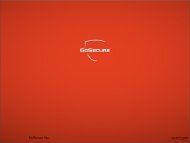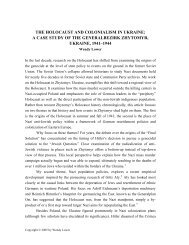Effects of Teachers' Mathematical Knowledge for Teaching on - Apple
Effects of Teachers' Mathematical Knowledge for Teaching on - Apple
Effects of Teachers' Mathematical Knowledge for Teaching on - Apple
You also want an ePaper? Increase the reach of your titles
YUMPU automatically turns print PDFs into web optimized ePapers that Google loves.
Hill, Rowan, & Ball<br />
power <str<strong>on</strong>g>of</str<strong>on</strong>g> 10 equals 1. He asked Ms. Berry, next door. What should she tell him? (Mark<br />
[X] ONE answer.)<br />
a) 0<br />
b) 1<br />
c) Ten cannot be raised to any power such that 10 to that power equals 1<br />
d) −1<br />
e) I’m not sure<br />
2. Imagine that you are working with your class <strong>on</strong> multiplying large numbers.<br />
Am<strong>on</strong>g your students’ papers, you notice that some have displayed their work in the<br />
following ways:<br />
Student A Student B Student C<br />
35 35 35<br />
× 25 × 25 × 25<br />
125 175 25<br />
+ 75 + 700 150<br />
875 875 100<br />
+ 600<br />
875<br />
Which <str<strong>on</strong>g>of</str<strong>on</strong>g> these students would you judge to be using a method that could be used to<br />
multiply any two whole numbers?<br />
Method would work Method would NOT<br />
<str<strong>on</strong>g>for</str<strong>on</strong>g> all work <str<strong>on</strong>g>for</str<strong>on</strong>g> all whole<br />
whole numbers numbers I’m not sure<br />
Method A 1 2 3<br />
Method B 1 2 3<br />
Method C 1 2 3<br />
Notes<br />
We thank Robert J. Miller, Ge<str<strong>on</strong>g>of</str<strong>on</strong>g>frey Phelps, Stephen G. Schilling, and Kathy Welch <str<strong>on</strong>g>for</str<strong>on</strong>g><br />
their assistance. We are resp<strong>on</strong>sible <str<strong>on</strong>g>for</str<strong>on</strong>g> any errors. The research reported in this article<br />
was supported in part by the U.S. Department <str<strong>on</strong>g>of</str<strong>on</strong>g> Educati<strong>on</strong> (Grants OERI-R308A60003 and<br />
OERI-R308B70003), the Nati<strong>on</strong>al Science Foundati<strong>on</strong> Interagency Educati<strong>on</strong>al Research<br />
Initiative (Grants REC-9979863 and REC-0129421), the William and Flora Hewlett Foundati<strong>on</strong>,<br />
and the Atlantic Philanthropies. The opini<strong>on</strong>s expressed are those <str<strong>on</strong>g>of</str<strong>on</strong>g> the authors and<br />
do not reflect the views <str<strong>on</strong>g>of</str<strong>on</strong>g> the U.S. Department <str<strong>on</strong>g>of</str<strong>on</strong>g> Educati<strong>on</strong>, the Nati<strong>on</strong>al Science Foundati<strong>on</strong>,<br />
the William and Flora Hewlett Foundati<strong>on</strong>, or the Atlantic Philanthropies.<br />
1 The Belize Nati<strong>on</strong>al Selecti<strong>on</strong> Exam measures students’ pr<str<strong>on</strong>g>of</str<strong>on</strong>g>iciency at 14 years <str<strong>on</strong>g>of</str<strong>on</strong>g> age,<br />
the equivalent in the United States <str<strong>on</strong>g>of</str<strong>on</strong>g> an end-<str<strong>on</strong>g>of</str<strong>on</strong>g>-eighth-grade exam.<br />
2 In the sampling technique used, school selecti<strong>on</strong> was based <strong>on</strong> geographic locati<strong>on</strong>,<br />
year <str<strong>on</strong>g>of</str<strong>on</strong>g> entry into Comprehensive School Re<str<strong>on</strong>g>for</str<strong>on</strong>g>m program, and an index <str<strong>on</strong>g>of</str<strong>on</strong>g> community disadvantage.<br />
The last criteri<strong>on</strong> ensured comparable schools within each Comprehensive<br />
School Re<str<strong>on</strong>g>for</str<strong>on</strong>g>m program. For additi<strong>on</strong>al details <strong>on</strong> the sampling process, see Bens<strong>on</strong> (2002).<br />
3 This table does not provide a comparis<strong>on</strong> <str<strong>on</strong>g>of</str<strong>on</strong>g> the exact set <str<strong>on</strong>g>of</str<strong>on</strong>g> students in our analyses<br />
with Early Childhood L<strong>on</strong>gitudinal Study students; instead, the comparis<strong>on</strong> involves all students<br />
who were in kindergarten at the time our study began. Many, but not all, <str<strong>on</strong>g>of</str<strong>on</strong>g> these students<br />
were part <str<strong>on</strong>g>of</str<strong>on</strong>g> the first-grade cohort described here. Also, students leaving the study were<br />
replaced by randomly sampled new students, whose in<str<strong>on</strong>g>for</str<strong>on</strong>g>mati<strong>on</strong> is not included in Table 1.<br />
402




